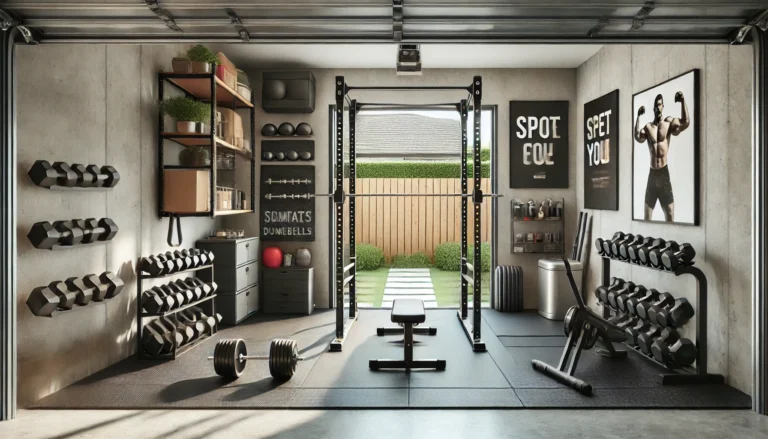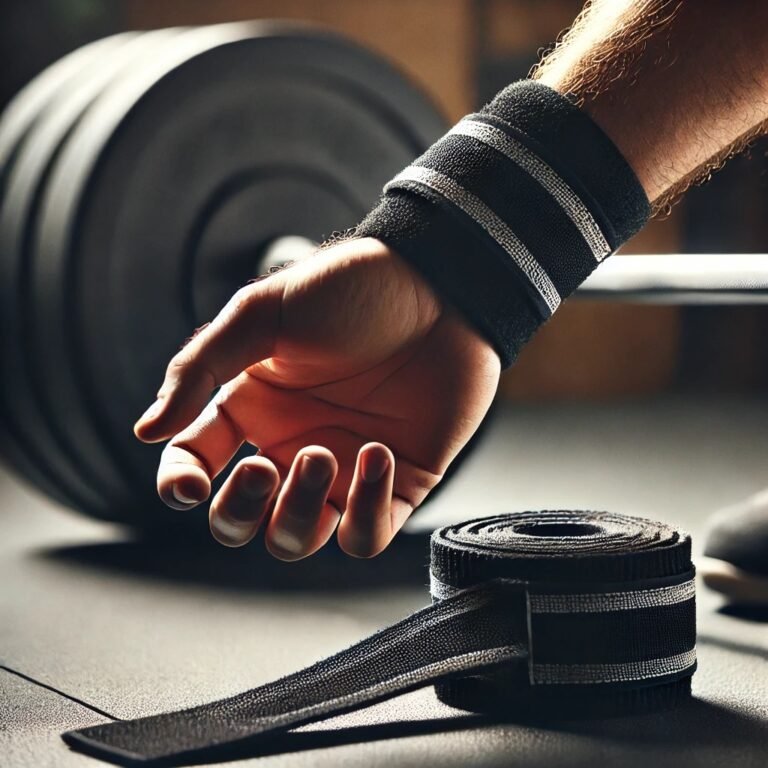Creating a fitness space at home has never been more accessible, and small garage gym ideas are becoming increasingly popular for those looking to maximize their space without compromising their workouts. Whether you have a single-car garage or just a corner to spare, a small yet functional gym can be the perfect solution for staying fit and saving time.
A small garage gym offers countless benefits—it’s convenient, cost-effective, and completely customizable to suit your fitness goals. With the right planning, you can transform even the tightest spaces into a versatile workout zone, giving you everything you need to build strength, improve endurance, or simply stay active.
In this guide, we’ll walk you through the essentials, from setup tips to space-saving solutions and frequently asked questions, ensuring your garage gym becomes a practical and inspiring place to achieve your fitness goals.
Is a Small Garage Gym a Good Idea?
A small garage gym can be an excellent idea for anyone looking to create a personal workout space at home. It offers numerous advantages, making it a worthwhile investment for both fitness enthusiasts and beginners. Let’s explore why a garage gym might be the perfect fit for your needs and address some challenges you might encounter along the way.
Advantages of a Garage Gym
- Convenience:
Having a gym right at home means you can work out whenever it suits you, without worrying about travel time or gym hours. Whether it’s a quick morning session or a late-night sweat, your garage gym is always open. - Cost-Effectiveness:
While there is an initial investment in equipment, a garage gym can save you money in the long run. Say goodbye to monthly membership fees, transportation costs, and locker rentals. Plus, you can gradually build your setup based on your budget. Check out our Ultimate Guide to Home Gym Equipment for affordable and essential items to get started. - Customization:
Unlike a commercial gym, a garage gym allows you to tailor the space to your preferences. Choose equipment that suits your workout style, decorate it to keep yourself motivated, and create a layout that works best for your available space. Need ideas? Visit our Top Garage Gym Ideas for inspiration.
Challenges
Solutions
Limited Space:
Garages often have a small footprint, but that doesn’t mean you can’t make it work. Utilize vertical storage solutions like wall-mounted racks and hooks to free up floor space. Multi-functional equipment, such as adjustable dumbbells or folding benches, can also help you maximize your space.
Ventilation and Temperature Control:
Garages can get hot in the summer and cold in the winter, which might make working out uncomfortable. To address this, consider adding a fan, portable heater, or an air conditioner to regulate the temperature. Insulating the garage door can also help maintain a comfortable workout environment. This guide on garage insulation can provide helpful tips.
Flooring Concerns:
Garage floors are often hard and slippery, which isn’t ideal for workouts. Adding gym flooring, such as rubber mats or foam tiles, can provide cushioning and grip for safer, more comfortable exercises. Learn more about gym flooring options here.

Why It’s Worth It
Despite the challenges, a garage gym can be a transformative addition to your home. It offers a private, personalized space to achieve your fitness goals on your own terms. By planning effectively and investing in versatile equipment, you can overcome common obstacles and create a gym that works perfectly for your lifestyle.
How to Set Up a Small Garage Gym
Setting up a small garage gym may seem like a daunting task, but with proper planning and organization, you can create a personalised fitness paradise to fit your needs. Follow these step-by-step instructions to transform your garage into a compact yet versatile gym tailored to your needs.
Step 1: Assess Your Space
- Measure Your Garage: Start by measuring your available space. Take note of the height, width, and depth to determine what equipment will fit comfortably.
- Identify Zones: Divide your garage into zones based on your workout needs (e.g., cardio area, strength training, or stretching).
- Consider Accessibility: Ensure your layout doesn’t obstruct doors, storage, or vehicles if the garage serves multiple purposes.
Pro Tip: Visit the HomeGym and GargeGym community pages on reddit to see real-world examples of garage gym setups and get creative layout ideas.
Step 2: Plan the Layout
- Prioritize Multi-Use Equipment: Opt for items like folding benches, adjustable dumbbells, and wall-mounted pull-up bars to save space.
- Leave Room for Movement: Ensure there’s enough open space for bodyweight exercises, stretching, or dynamic movements like lunges.
Inspiration: Browse Pinterest garage gym boards for visual ideas and unique configurations.

Step 3: Choose the Essentials
- Flooring:
Garage floors are often concrete, which can be slippery and hard on joints. Invest in high-quality gym flooring such as rubber mats or foam tiles for cushioning and grip.- Learn more from Garage Gym Reviews on the best flooring options.
- Lighting:
Proper lighting can make a huge difference. Replace dim or harsh garage lights with bright, energy-efficient LED bulbs. Consider adding task lighting for areas like weight racks or cardio machines. - Storage Solutions:
Maximize your vertical space with wall-mounted shelves, pegboards, and hooks to store equipment. Rolling carts and stackable bins can also help keep smaller items organized.
DIY Tip: Check out here for some small garage gym ideas for storage options here
Step 4: Personalize Your Space
- Add motivational posters, a mirror for form checks, or a Bluetooth speaker for workout music.
- Create a workout calendar or whiteboard to track your fitness progress.
Join the Conversation: The best way to find inspiration when creating your garage gym is to look on Pinterest here’s some of our favourites.
Step 5: Start Small and Expand
Begin with basic equipment like resistance bands, kettlebells, and a yoga mat. As you refine your workouts, you can gradually invest in larger items like a power rack or a compact treadmill. Starting small is the best way to grow your small garage gym as it allows you to grow with your gym and minimises costs.
By following these steps and utilizing the resources provided, you’ll have a small garage gym that’s not only functional but also a source of inspiration for your fitness journey.
Maximizing Small Spaces
When working with limited space, making the most of every square foot is essential. A small garage gym can still be highly functional and versatile if you use smart storage solutions and choose multi-purpose equipment. Here are some practical tips to maximize your small gym space effectively.
Utilize Vertical Storage

- Wall-Mounted Racks:
Save floor space by installing wall-mounted racks for barbells, weight plates, or resistance bands. Pegboards can also be used to organize smaller items like jump ropes or gloves.- For ideas, check out this guide on wall-mounted storage.
- Overhead Storage:
Utilize the ceiling for items you don’t need daily, like foam rollers or yoga mats, by installing overhead storage racks. Just make sure they are sturdy and safe. - Hooks and Hangers:
Simple hooks can be game-changers for storing items like kettlebells or TRX straps. Magnetic strips can also be used for small metal tools or accessories.- Explore creative storage solutions on Pinterest for additional inspiration.
Invest in Multi-Functional Equipment
- Adjustable Dumbbells:
Replace a full set of dumbbells with one adjustable set that lets you change the weight as needed. This can save both space and money. Popular options like Bowflex Adjustable Dumbbells are perfect for small gyms. - Folding Benches:
Folding benches are a great option for small spaces as they can be stored flat against a wall when not in use. Look for lightweight yet sturdy options for ease of handling.- Find the best folding benches on Garage Gym Reviews.
- Compact Machines:
Consider compact versions of cardio machines, like folding treadmills or under-desk ellipticals. These can be tucked away when not in use, freeing up space for other activities. - Resistance Bands:
These lightweight and versatile tools take up virtually no space and can replace bulky machines for many strength and flexibility exercises.
Smart Storage Hacks
- Use stackable storage bins for items like foam blocks or gloves.
- Repurpose old bookshelves or cabinets to store smaller items and free up floor space.
- Install mirrors to create the illusion of a larger space and improve visibility during workouts.
By combining efficient vertical storage solutions and versatile equipment, you can create a fully functional workout space even in the smallest garages. Thoughtful planning and smart investments can turn limited square footage into a gym that meets all your fitness needs.
Budget-Friendly Garage Gym Ideas
Building a small garage gym doesn’t have to break the bank. There are loads of ways you can furnish your garage gym to fit all your needs. With some creativity and resourcefulness, you can create a functional workout space on a budget. Here are practical tips and affordable equipment options to help you set up your gym without overspending.
1. Use Second-Hand Equipment
- Check Online Marketplaces:
Platforms like Facebook Marketplace, Craigslist, and eBay are excellent places to find second-hand fitness equipment at a fraction of the cost. Look for items like dumbbells, kettlebells, benches, and cardio machines.- Tip: Search for “eBay” or “Facebook marketplace” in your area for potential bargains.
- Join Local Community Groups:
Many neighborhoods have online groups where people give away or sell items. Look for free or low-cost fitness gear in groups like Buy Nothing or Freecycle. - Refurbish Old Equipment:
Sometimes second-hand items may need a bit of TLC. A coat of paint or a simple repair can make used equipment feel brand new.
2. Get Creative with DIY Solutions
- Build Your Own Equipment:
- Use sturdy wood to create a plyometric box for jump exercises.
- Fill sandbags for weighted training or create DIY medicine balls with old basketballs and sand.
- Construct a basic squat rack using wood and metal brackets. Tutorials are available on YouTube for these projects.
- Flooring on a Budget:
Instead of buying expensive gym mats, consider using horse stall mats, which are durable and significantly cheaper. They are widely available at farm supply stores.
3. Affordable Equipment Options
- Resistance Bands:
A versatile and cost-effective option for strength training, mobility work, and stretching. They’re compact and ideal for small spaces. - Adjustable Dumbbells:
While the initial cost may be higher, adjustable dumbbells eliminate the need to buy multiple weights, saving money and space in the long run. - Kettlebells:
Look for iron kettlebells, which are often cheaper than fancy rubber-coated options, especially on second-hand marketplaces. - Jump Rope:
A simple, effective, and budget-friendly tool for cardio. It’s perfect for small spaces and can often be found for under $10. - Pull-Up Bars:
Doorway pull-up bars are inexpensive and provide a great upper body workout option.
4. Where to Find Deals
- Supermarkets
Retailers like Tesco, Asda and Aldi have loads of deals popping up on cheap and valuable equipment that will surprisingly make a big difference. - Discount Stores:
Stores like TK Max will sometimes have fitness gear like yoga mats, dumbbells, or resistance bands at reduced prices. - Sales Events:
Keep an eye out for holiday sales like Black Friday, Cyber Monday, and end-of-season clearances. Fitness brands often offer discounts during these times.
With these tips and affordable options, you can set up a fully functional garage gym without going over budget. Whether you’re hunting for deals, building DIY equipment, or choosing cost-effective gear, every step will bring you closer to your fitness goals without the hefty price tag.
Workout Zone Inspiration
Dividing your small garage gym into designated areas will help maximise space and efficiency. When designing your garage gym it involves a lot more than functionality its also about making a space that motivates you and encourages you to go in there and workout. Organising your garage gym into specific workout zones can be challenging, here are some tips and layout designing to help you create your perfect garage gym setup.
1. Cardio Corner
Check out our ultimate guide on The Best Cardio Machines for Your Home Gym Here
- What It Looks Like:
Dedicate one section of your garage to cardio equipment like a compact treadmill, rowing machine, or spin bike. Arrange them side by side or at an angle to save space. Add a small shelf for water bottles, towels, and a phone holder. - Aesthetic Tips:
- Use a vibrant wall decal or poster of a scenic trail to create an immersive workout vibe.
- Place a fan or portable air conditioner nearby to keep your workouts comfortable.
- Here’s Some Essential Machines and Guides to Add to your Gym:
- Battle ropes
- Ellipticals
- Stairmaster
- Treadmill
2. Strength-Training Area
- What It Looks Like:
Include essential equipment like a power rack, adjustable dumbbells, and a folding weight bench. Use wall-mounted racks or shelves for storing plates, bars, and kettlebells to keep the area tidy. - Aesthetic Tips:
- Hang a large mirror to check your form and make the space feel bigger.
- Add a rubber mat or interlocking tiles for durability and soundproofing.
Pro Tip: Use dark-colored mats or flooring for a sleek, professional gym look.
3. Functional Training Zone
- What It Looks Like:
This zone is ideal for bodyweight exercises, yoga, or stretching. Keep it open and clutter-free with items like resistance bands, foam rollers, and a yoga mat stored neatly in a corner. - Aesthetic Tips:
- Add soft LED strip lighting to create a calm and focused atmosphere.
- Use a corkboard or chalkboard to write motivational quotes or display your workout plan.
4. Multipurpose Wall Space
- What It Looks Like:
Install pegboards or wall hooks to store lightweight equipment like jump ropes, TRX straps, or medicine balls. A foldable wall-mounted bench can serve as both storage and a workout station. - Aesthetic Tips:
- Paint the wall in a bright, energizing color like blue or green.
- Add a grid wall organizer to keep smaller items like gloves and resistance bands in order.

5. Aesthetic Add-Ons
- Lighting:
- Use adjustable LED lights to create a bright, professional-looking space.
- Install motion-sensor lights for energy efficiency and convenience.
- Color Scheme:
Stick to a consistent color palette for your equipment, walls, and flooring to create a cohesive look. Neutral tones like black, grey, and white work well, or you can opt for pops of bold color. - Decor:
Add motivational posters, inspirational quotes, or even a small indoor plant to liven up the space. Personalized touches make the gym feel more inviting.
6. Compact Layout Example
- Scenario: Single-Car Garage (~10×20 ft)
- Cardio Corner: Place a folding treadmill or rowing machine near the garage door for airflow.
- Strength-Training Area: Use the side wall for a power rack and wall-mounted storage for weights.
- Functional Training Zone: Keep an open space near the back with mats and resistance bands.
By dividing your garage into zones and adding small personal touches, you can create an inspiring, efficient, and visually pleasing workout space. Whether you focus on cardio, strength, or functional training, a well-thought-out design can keep you motivated and excited to work out every day.
Frequently Asked Questions
When setting up a small garage gym, it’s natural to have questions about costs, space management, and ensuring the gym’s longevity. Below, we’ve answered some of the most common queries to help you create a functional and durable workout space.
1. How Much Does It Cost to Set Up a Small Garage Gym?
The cost of setting up a small garage gym can vary widely depending on your equipment choices and whether you opt for new or second-hand items. Here’s a rough breakdown:
- Basic Setup (Essentials Only): £300 – £700
- Includes adjustable dumbbells, resistance bands, a jump rope, and a folding bench.
- Mid-Range Setup: £1000 – £1700
- Adds equipment like a power rack, barbell and plates, and a compact treadmill or rowing machine.
- Premium Setup: £2000
- Includes specialized equipment like cable machines, higher-end cardio machines, and custom flooring.
To save money, consider buying second-hand equipment from platforms like Facebook Marketplace or exploring sales during holidays like Black Friday.
2. How Can I Make the Space Weather-Proof?
Garages are often exposed to temperature fluctuations, humidity, and dust, which can affect both your comfort and the longevity of your equipment. Here’s how to protect your space:
- Temperature Control:
- Add insulation to the walls and garage door to maintain a more stable temperature.
- Use a portable heater in the winter and a fan or portable AC unit in the summer.
- Humidity Management:
- Install a dehumidifier to prevent rust on metal equipment and reduce mold growth.
- Dust and Dirt Control:
- Sweep and mop the garage regularly.
- Use door seals or weatherstripping to keep dirt out.
For a detailed guide on insulating your garage, check out this step-by-step tutorial.
3. What’s the Best Way to Organize Gym Equipment in a Small Space?
Efficient organization is key to making a small garage gym functional and clutter-free. Here are some tips:
- Use Vertical Storage:
Install wall-mounted racks or hooks for items like barbells, plates, resistance bands, and jump ropes. Pegboards are also great for organizing smaller items. - Invest in Multi-Purpose Storage:
Opt for shelving units with baskets or bins to store smaller accessories like gloves and foam rollers. Rolling carts can double as movable storage solutions. - Keep the Floor Clear:
Store larger equipment like benches or treadmills along the walls when not in use. Folding or compact versions of equipment can save significant space.
Explore more organization ideas on Pinterest or the r/homegym subreddit, where users share creative layouts and hacks.
Conclusion
A small garage gym is more than just a space to work out—it’s a personal haven that brings convenience, cost savings, and customization to your fitness routine. By following the key steps outlined in this guide—assessing your space, using vertical storage, choosing multi-functional equipment, and organizing effectively—you can transform even the smallest garage into a functional and inspiring workout zone.
The journey to creating your garage gym starts with a plan. Whether you’re on a tight budget or looking to build a premium setup, every step you take brings you closer to your fitness goals. To dive deeper into selecting the right gear, check out our detailed Home Gym Equipment guide, and for additional inspiration, explore our Top Garage Gym Ideas and also for you fitness enthusiast check out The Best Cardio Machines for Your Home Gym.
Remember, the first step is often the hardest, but it’s also the most rewarding. Start small, be resourceful, and let your garage gym evolve with your fitness journey. Your dream workout space is within reach—now it’s time to make it a reality. Stay motivated, take action, and enjoy the benefits of fitness right at home!





